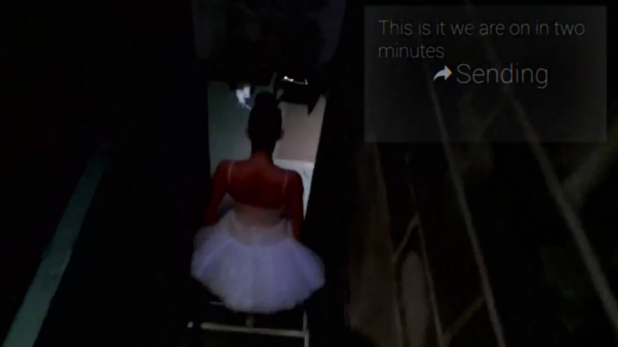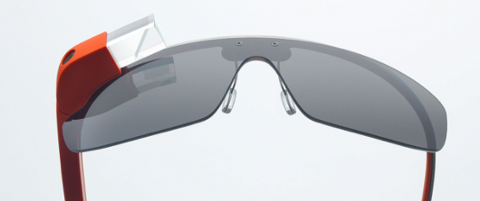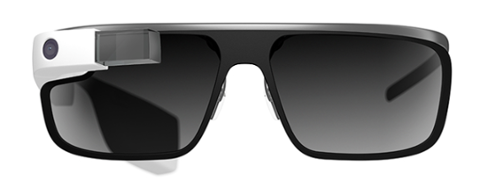 Google Glass could go on sale sometime within the next year.[/caption] The kernel code for Google Glass, Google’s augmented-reality eyewear, is now available for download in a convenient 65.7MB file. “Currently there is a tarball of the kernel source in downloads,” read a short note on code.google.com. “This is unlikely to be the permanent home for the kernel source, it should be pushed into git next to all other android kernel source releases relatively soon, at which point, i'll update this notice.” The code is available under GNU General Public License v2.0. Two days after Google made the kernel code available, developers had downloaded it some 6,150 times. A few publications have already begun picking through the software, including Karthik’s Geek Center (hat-tip to CNET for citing it first), which found snippets suggesting Near-Field Communication (NFC) support. Even before the kernel release, developers were busy exploring the device’s capabilities. Over on Reddit, an inspection of the Google Glass companion app revealed a handful of revealing features, including “EYE_GESTURES_WINK_ENABLED,” and “EYE_GESTURES_WINK_TAKE_PHOTO,” which could open the door to a lot of public awkwardness—imagine winking to snap an image of a particularly lovely sunset, only to have a random bystander misinterpret the gesture as a flirt, leading to much hilarity for all involved. Google clearly wants to build some momentum behind Glass, releasing specs for the device earlier in April. In addition to a camera capable of snapping 5-megapixel photos and 720p video, the headset features 12GB of usable memory, synced with Google’s cloud storage (actual onboard storage is 16GB). Google Glass is compatible with any Bluetooth-capable phone. Its MyGlass app, which enables SMS messaging and GPS, requires a companion device running Android 4.0.3 (the “Ice Cream Sandwich” build) or higher. Google used this year’s South by Southwest conference in Austin, Texas to show off some apps currently under development for the eyewear; one from the New York Times, for example, fed headlines and images to the tiny screen embedded in the Google Glass lens. Other developers will surely take advantage of the device’s voice-recognition capabilities, camera, and processor. While Google Glass offers some exciting possibilities for third-party developers, who could craft some innovative apps, it also poses some difficult questions about the rise of surveillance culture. Do people really want whole crowds recording every moment of our collective lives? Does anyone “own” information captured by a Google Glass headset? Will Google eventually allow advertising on the platform? Such questions (and many more) abound. Image: Google
Google Glass could go on sale sometime within the next year.[/caption] The kernel code for Google Glass, Google’s augmented-reality eyewear, is now available for download in a convenient 65.7MB file. “Currently there is a tarball of the kernel source in downloads,” read a short note on code.google.com. “This is unlikely to be the permanent home for the kernel source, it should be pushed into git next to all other android kernel source releases relatively soon, at which point, i'll update this notice.” The code is available under GNU General Public License v2.0. Two days after Google made the kernel code available, developers had downloaded it some 6,150 times. A few publications have already begun picking through the software, including Karthik’s Geek Center (hat-tip to CNET for citing it first), which found snippets suggesting Near-Field Communication (NFC) support. Even before the kernel release, developers were busy exploring the device’s capabilities. Over on Reddit, an inspection of the Google Glass companion app revealed a handful of revealing features, including “EYE_GESTURES_WINK_ENABLED,” and “EYE_GESTURES_WINK_TAKE_PHOTO,” which could open the door to a lot of public awkwardness—imagine winking to snap an image of a particularly lovely sunset, only to have a random bystander misinterpret the gesture as a flirt, leading to much hilarity for all involved. Google clearly wants to build some momentum behind Glass, releasing specs for the device earlier in April. In addition to a camera capable of snapping 5-megapixel photos and 720p video, the headset features 12GB of usable memory, synced with Google’s cloud storage (actual onboard storage is 16GB). Google Glass is compatible with any Bluetooth-capable phone. Its MyGlass app, which enables SMS messaging and GPS, requires a companion device running Android 4.0.3 (the “Ice Cream Sandwich” build) or higher. Google used this year’s South by Southwest conference in Austin, Texas to show off some apps currently under development for the eyewear; one from the New York Times, for example, fed headlines and images to the tiny screen embedded in the Google Glass lens. Other developers will surely take advantage of the device’s voice-recognition capabilities, camera, and processor. While Google Glass offers some exciting possibilities for third-party developers, who could craft some innovative apps, it also poses some difficult questions about the rise of surveillance culture. Do people really want whole crowds recording every moment of our collective lives? Does anyone “own” information captured by a Google Glass headset? Will Google eventually allow advertising on the platform? Such questions (and many more) abound. Image: Google Google Glass Kernel Code Hits the Web
[caption id="attachment_9445" align="aligncenter" width="618"]  Google Glass could go on sale sometime within the next year.[/caption] The kernel code for Google Glass, Google’s augmented-reality eyewear, is now available for download in a convenient 65.7MB file. “Currently there is a tarball of the kernel source in downloads,” read a short note on code.google.com. “This is unlikely to be the permanent home for the kernel source, it should be pushed into git next to all other android kernel source releases relatively soon, at which point, i'll update this notice.” The code is available under GNU General Public License v2.0. Two days after Google made the kernel code available, developers had downloaded it some 6,150 times. A few publications have already begun picking through the software, including Karthik’s Geek Center (hat-tip to CNET for citing it first), which found snippets suggesting Near-Field Communication (NFC) support. Even before the kernel release, developers were busy exploring the device’s capabilities. Over on Reddit, an inspection of the Google Glass companion app revealed a handful of revealing features, including “EYE_GESTURES_WINK_ENABLED,” and “EYE_GESTURES_WINK_TAKE_PHOTO,” which could open the door to a lot of public awkwardness—imagine winking to snap an image of a particularly lovely sunset, only to have a random bystander misinterpret the gesture as a flirt, leading to much hilarity for all involved. Google clearly wants to build some momentum behind Glass, releasing specs for the device earlier in April. In addition to a camera capable of snapping 5-megapixel photos and 720p video, the headset features 12GB of usable memory, synced with Google’s cloud storage (actual onboard storage is 16GB). Google Glass is compatible with any Bluetooth-capable phone. Its MyGlass app, which enables SMS messaging and GPS, requires a companion device running Android 4.0.3 (the “Ice Cream Sandwich” build) or higher. Google used this year’s South by Southwest conference in Austin, Texas to show off some apps currently under development for the eyewear; one from the New York Times, for example, fed headlines and images to the tiny screen embedded in the Google Glass lens. Other developers will surely take advantage of the device’s voice-recognition capabilities, camera, and processor. While Google Glass offers some exciting possibilities for third-party developers, who could craft some innovative apps, it also poses some difficult questions about the rise of surveillance culture. Do people really want whole crowds recording every moment of our collective lives? Does anyone “own” information captured by a Google Glass headset? Will Google eventually allow advertising on the platform? Such questions (and many more) abound. Image: Google
Google Glass could go on sale sometime within the next year.[/caption] The kernel code for Google Glass, Google’s augmented-reality eyewear, is now available for download in a convenient 65.7MB file. “Currently there is a tarball of the kernel source in downloads,” read a short note on code.google.com. “This is unlikely to be the permanent home for the kernel source, it should be pushed into git next to all other android kernel source releases relatively soon, at which point, i'll update this notice.” The code is available under GNU General Public License v2.0. Two days after Google made the kernel code available, developers had downloaded it some 6,150 times. A few publications have already begun picking through the software, including Karthik’s Geek Center (hat-tip to CNET for citing it first), which found snippets suggesting Near-Field Communication (NFC) support. Even before the kernel release, developers were busy exploring the device’s capabilities. Over on Reddit, an inspection of the Google Glass companion app revealed a handful of revealing features, including “EYE_GESTURES_WINK_ENABLED,” and “EYE_GESTURES_WINK_TAKE_PHOTO,” which could open the door to a lot of public awkwardness—imagine winking to snap an image of a particularly lovely sunset, only to have a random bystander misinterpret the gesture as a flirt, leading to much hilarity for all involved. Google clearly wants to build some momentum behind Glass, releasing specs for the device earlier in April. In addition to a camera capable of snapping 5-megapixel photos and 720p video, the headset features 12GB of usable memory, synced with Google’s cloud storage (actual onboard storage is 16GB). Google Glass is compatible with any Bluetooth-capable phone. Its MyGlass app, which enables SMS messaging and GPS, requires a companion device running Android 4.0.3 (the “Ice Cream Sandwich” build) or higher. Google used this year’s South by Southwest conference in Austin, Texas to show off some apps currently under development for the eyewear; one from the New York Times, for example, fed headlines and images to the tiny screen embedded in the Google Glass lens. Other developers will surely take advantage of the device’s voice-recognition capabilities, camera, and processor. While Google Glass offers some exciting possibilities for third-party developers, who could craft some innovative apps, it also poses some difficult questions about the rise of surveillance culture. Do people really want whole crowds recording every moment of our collective lives? Does anyone “own” information captured by a Google Glass headset? Will Google eventually allow advertising on the platform? Such questions (and many more) abound. Image: Google
 Google Glass could go on sale sometime within the next year.[/caption] The kernel code for Google Glass, Google’s augmented-reality eyewear, is now available for download in a convenient 65.7MB file. “Currently there is a tarball of the kernel source in downloads,” read a short note on code.google.com. “This is unlikely to be the permanent home for the kernel source, it should be pushed into git next to all other android kernel source releases relatively soon, at which point, i'll update this notice.” The code is available under GNU General Public License v2.0. Two days after Google made the kernel code available, developers had downloaded it some 6,150 times. A few publications have already begun picking through the software, including Karthik’s Geek Center (hat-tip to CNET for citing it first), which found snippets suggesting Near-Field Communication (NFC) support. Even before the kernel release, developers were busy exploring the device’s capabilities. Over on Reddit, an inspection of the Google Glass companion app revealed a handful of revealing features, including “EYE_GESTURES_WINK_ENABLED,” and “EYE_GESTURES_WINK_TAKE_PHOTO,” which could open the door to a lot of public awkwardness—imagine winking to snap an image of a particularly lovely sunset, only to have a random bystander misinterpret the gesture as a flirt, leading to much hilarity for all involved. Google clearly wants to build some momentum behind Glass, releasing specs for the device earlier in April. In addition to a camera capable of snapping 5-megapixel photos and 720p video, the headset features 12GB of usable memory, synced with Google’s cloud storage (actual onboard storage is 16GB). Google Glass is compatible with any Bluetooth-capable phone. Its MyGlass app, which enables SMS messaging and GPS, requires a companion device running Android 4.0.3 (the “Ice Cream Sandwich” build) or higher. Google used this year’s South by Southwest conference in Austin, Texas to show off some apps currently under development for the eyewear; one from the New York Times, for example, fed headlines and images to the tiny screen embedded in the Google Glass lens. Other developers will surely take advantage of the device’s voice-recognition capabilities, camera, and processor. While Google Glass offers some exciting possibilities for third-party developers, who could craft some innovative apps, it also poses some difficult questions about the rise of surveillance culture. Do people really want whole crowds recording every moment of our collective lives? Does anyone “own” information captured by a Google Glass headset? Will Google eventually allow advertising on the platform? Such questions (and many more) abound. Image: Google
Google Glass could go on sale sometime within the next year.[/caption] The kernel code for Google Glass, Google’s augmented-reality eyewear, is now available for download in a convenient 65.7MB file. “Currently there is a tarball of the kernel source in downloads,” read a short note on code.google.com. “This is unlikely to be the permanent home for the kernel source, it should be pushed into git next to all other android kernel source releases relatively soon, at which point, i'll update this notice.” The code is available under GNU General Public License v2.0. Two days after Google made the kernel code available, developers had downloaded it some 6,150 times. A few publications have already begun picking through the software, including Karthik’s Geek Center (hat-tip to CNET for citing it first), which found snippets suggesting Near-Field Communication (NFC) support. Even before the kernel release, developers were busy exploring the device’s capabilities. Over on Reddit, an inspection of the Google Glass companion app revealed a handful of revealing features, including “EYE_GESTURES_WINK_ENABLED,” and “EYE_GESTURES_WINK_TAKE_PHOTO,” which could open the door to a lot of public awkwardness—imagine winking to snap an image of a particularly lovely sunset, only to have a random bystander misinterpret the gesture as a flirt, leading to much hilarity for all involved. Google clearly wants to build some momentum behind Glass, releasing specs for the device earlier in April. In addition to a camera capable of snapping 5-megapixel photos and 720p video, the headset features 12GB of usable memory, synced with Google’s cloud storage (actual onboard storage is 16GB). Google Glass is compatible with any Bluetooth-capable phone. Its MyGlass app, which enables SMS messaging and GPS, requires a companion device running Android 4.0.3 (the “Ice Cream Sandwich” build) or higher. Google used this year’s South by Southwest conference in Austin, Texas to show off some apps currently under development for the eyewear; one from the New York Times, for example, fed headlines and images to the tiny screen embedded in the Google Glass lens. Other developers will surely take advantage of the device’s voice-recognition capabilities, camera, and processor. While Google Glass offers some exciting possibilities for third-party developers, who could craft some innovative apps, it also poses some difficult questions about the rise of surveillance culture. Do people really want whole crowds recording every moment of our collective lives? Does anyone “own” information captured by a Google Glass headset? Will Google eventually allow advertising on the platform? Such questions (and many more) abound. Image: Google 
